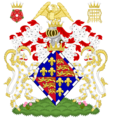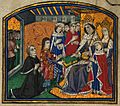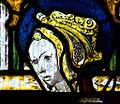Lady Margaret Beaufort facts for kids
Quick facts for kids
Lady
Margaret Beaufort
|
|
|---|---|
| The King's Mother Countess of Richmond and Derby |
|
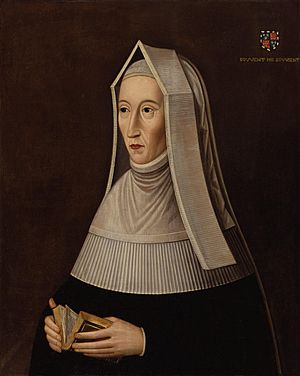
Posthumous portrait, 16th century
|
|
| Born | 31 May 1443 Bletsoe Castle, Bedfordshire, England |
| Died | 29 June 1509 (aged 66) London, England |
| Buried | Henry VII Lady Chapel, Westminster Abbey |
| Noble family | Beaufort |
| Spouse(s) |
|
| Issue | Henry VII of England |
| Father | John Beaufort, Duke of Somerset |
| Mother | Margaret Beauchamp of Bletso |
Lady Margaret Beaufort (born 31 May 1443 – died 29 June 1509) was a very important person in English history. She lived during the Wars of the Roses, a time when two powerful families fought for the English throne. Margaret was the mother of King Henry VII, who became the first king of the Tudor dynasty.
Margaret was related to King Edward III. She helped her son, Henry Tudor, claim the English throne. She worked hard behind the scenes to make sure Henry became king. Her efforts led to Henry's big win against King Richard III at the Battle of Bosworth Field. This battle changed England's history forever.
After Henry became King Henry VII, Margaret had a lot of power and freedom. This was unusual for women back then. She also supported many artists and scholars. She helped start two famous colleges at Cambridge University. These were Christ's College in 1505 and St John's College in 1511. Lady Margaret Hall, Oxford, the first college at Oxford to accept women, was named after her.
Contents
Margaret's Family and Early Life
Margaret was the only child of John Beaufort, Duke of Somerset. Her grandfather was John of Gaunt, a son of King Edward III. Margaret was born at Bletsoe Castle in Bedfordshire on 31 May 1443. We know the day and month are correct because she always celebrated her birthday on May 31st.
When Margaret was born, her father was getting ready to lead an army in France. He made sure that if he died, his wife would be in charge of Margaret's future. This was important because Margaret was his only heir. If a powerful lord died, the king usually decided who would take care of their children and lands. This was called "wardship."
Margaret's father died soon after returning from France. This made Margaret the heir to his large fortune and his claim to the throne. Because of this, Margaret was like a "pawn" in the political games of the time. She was a valuable person that powerful people wanted to control.
When Margaret was one year old, the king changed the plan her father had made. He gave Margaret's lands to William de la Pole, 1st Duke of Suffolk. But Margaret stayed with her mother.
Margaret's First Marriages
Margaret was first married to Suffolk's son, John de la Pole. This wedding might have happened when she was only one to three years old. But it's more likely they married in January 1450, when she was six. This was after Suffolk was arrested and wanted to secure his son's future. The marriage was later cancelled. Margaret never saw this marriage as real.
King Henry VI then chose Margaret to marry his half-brother, Edmund Tudor, 1st Earl of Richmond. This was to make Edmund's claim to the throne stronger. Margaret was nine years old when she agreed to this marriage. She later said she felt guided by God to do it.
Margaret married Edmund Tudor on 1 November 1455. She was twelve and he was twelve years older. The Wars of the Roses had just begun. Less than a year later, Edmund was captured by the rival Yorkist forces. He died of the plague on 3 November 1456. Margaret was only thirteen years old and pregnant with their child.
Margaret always respected Edmund as the father of her only child. Years later, she even wanted to be buried next to him.
Becoming a Mother
On 28 January 1457, Margaret gave birth to her son, Henry Tudor, at Pembroke Castle. She was only thirteen. The birth was very difficult because she was so young. Her confessor, John Fisher, later called it a miracle that a baby could be born from "so little a personage." Margaret never had another child after this.
After Henry was born, Margaret's brother-in-law, Jasper Tudor, helped her arrange another marriage. This was to keep her son safe. On 3 January 1458, when she was fourteen, Margaret married Sir Henry Stafford. They were distant cousins, so they needed special permission to marry. They had a happy marriage and lived at Woking Palace. They could visit Margaret's son, Henry, who was being cared for by Jasper Tudor in Wales.
Margaret's Role in the Wars of the Roses
During Edward IV's Reign
The Wars of the Roses were a long struggle for power. In 1461, the Yorkist side won the Battle of Towton. Edward IV became King. Margaret's father-in-law died in the fighting. Jasper Tudor had to flee to Scotland and France to find support for the Lancastrian side. King Edward IV gave Margaret's son's lands to his own brother. Henry became the ward of Sir William Herbert. Margaret was still allowed to visit her son sometimes.
In 1469, some powerful nobles rebelled against Edward IV. Margaret tried to use this chance to get her son and his lands back. But Edward soon regained power.
In 1470, the Lancastrian King Henry VI was briefly put back on the throne. But the Yorkists won again at the Battle of Barnet. Margaret asked Jasper Tudor to take her thirteen-year-old son, Henry, with him when he fled England again. Margaret would not see her son for fourteen years.
In 1471, Margaret's husband, Lord Stafford, died from wounds he got fighting for the Yorkists. Margaret was 28 and a widow again.
In June 1472, Margaret married Thomas Stanley. This marriage was mainly for convenience. It allowed Margaret to return to the court of King Edward IV and Queen Elizabeth. Margaret even became godmother to one of Queen Elizabeth's daughters.
During Edward V and Richard III's Reigns
After King Edward IV died in April 1483, his brother Richard took the throne from young Edward V. Margaret served the new queen, Anne Neville. Margaret even carried Anne's dress at the coronation. Margaret tried to get her son back to England by talking with Richard.
But Margaret also secretly planned with Elizabeth Woodville, the mother of the two young princes who were held in the Tower of London. Rumors spread that the boys had been killed. Margaret then started to hope her son could become king.
Margaret and Elizabeth Woodville secretly communicated through a doctor. They planned to remove King Richard from the throne. They wanted to replace him with Margaret's son, Henry Tudor. They also agreed that Henry would marry Elizabeth of York, Edward IV's daughter. This plan would bring together supporters from both the Yorkist and Lancastrian families.
Many historians believe that Richard III ordered the deaths of his nephews to secure his rule. However, some suggest that Margaret might have played a role in their disappearance. Their absence certainly made it easier for Henry Tudor to become king. But most historical accounts praise Margaret's courage and loyalty to her family. They describe her as a very religious and wise woman.
In 1483, Margaret was involved in a rebellion led by Buckingham. Margaret helped pay for this uprising. Her son was supposed to join them, but he arrived too late. The rebellion failed, and Buckingham was executed. Henry Tudor had to flee back across the English Channel.
King Richard did not punish Margaret too harshly. He transferred her property to her husband, Lord Stanley. He also kept Margaret at her husband's home to stop her from talking to her son. But her husband failed to stop Margaret's secret messages to Henry. When Henry was ready to claim the throne, his mother helped him gather support in England.
Margaret's husband, Stanley, did not fight for Richard III at the Battle of Bosworth Field in 1485. After Henry Tudor won the battle, Stanley placed the crown on his stepson's head. Henry then made Stanley the Earl of Derby. Margaret was called "Countess of Richmond and Derby."
Margaret Beaufort in Power
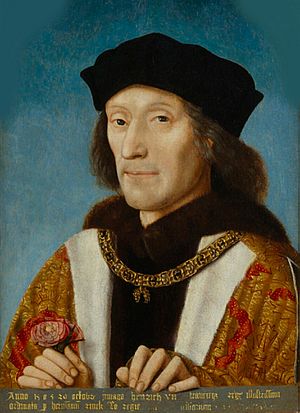
After her son became King Henry VII, Margaret was known as "My Lady the King's Mother." The Parliament made a special law for her. It said she was a feme sole. This meant she had a lot of legal freedom, like an unmarried woman. She could own property and go to court on her own. These were rights most married women did not have.
Henry married Elizabeth of York, as their mothers had planned. Margaret was very proud and wanted to have a high status at court. She wore clothes as fine as the queen's and walked just behind her.
Margaret had signed her name as M. Richmond for many years. In 1499, she changed it to Margaret R., perhaps to show her royal authority. The "R" could stand for "regina" (queen in Latin) or for Richmond. She also added "and mother of Henry VII, king of England and Ireland" to her signature.
Margaret had a lot of political influence in the Tudor court. A Spanish envoy reported in 1498 that Henry was "much influenced by his mother." Margaret often traveled with the King and Queen.
Margaret worked hard to gain her special position. She wanted to be a powerful "king's mother." Her first requests were for independence and freedom, not to rule over others.
Parliament passed two important laws for Margaret. The first gave her back all the properties she had lost under Richard III. The second law, passed in November 1485, said she could use her properties and titles as if she were unmarried. This was even though she was still married. These laws helped both Margaret and Henry. They gave Margaret power without giving more influence to her husband's family.
Henry VII shared many of his resources with his mother. He wrote to her, saying he would be glad to please her in "all other things that I may know should be to your honour and pleasure."
Margaret also took care of young noble brothers, Edward Stafford, 3rd Duke of Buckingham, and Henry Stafford, 1st Earl of Wiltshire. She did not ask for money for this. She helped make sure the Duke of Buckingham stayed loyal to King Henry Tudor.
Later in her marriage, Margaret preferred to live alone. In 1499, with her husband's permission, she made a vow of chastity. This meant she would live a religious life without physical intimacy. She moved away from her husband and lived at Collyweston. Her husband still visited her regularly. From Collyweston, she was given a special job to oversee justice in the Midlands and the North of England.
Margaret was also involved in the royal family's home life. She created rules for how royal children should be born and raised. She worked with her daughter-in-law, Queen Elizabeth, to plan the royal children's marriages. They both tried to stop their granddaughter, Margaret, from marrying the Scottish king too young. Margaret did not want her granddaughter to have the same difficult experience she had.
After Queen Elizabeth died in 1503, Margaret became the most important woman at court. When her grandson Arthur died, Margaret helped choose members of the new household for the next heir, Henry.
Margaret was known for being educated and very religious. Her biographers say her whole life was about her "deeply-felt love and loyalty to her son." Henry was also very devoted to her.
King Henry VII died on 21 April 1509. He named his mother as the main person to carry out his will. For two days after his death, Margaret worked hard to make sure her grandson, Henry VIII, became king smoothly. She planned her son's funeral and her grandson's coronation. At her son's funeral, she was given the highest place among all the royal women.
Before she died, Margaret also influenced Henry VIII's early rule. When her eighteen-year-old grandson chose his advisors, he took Margaret's suggestions.
Margaret's Death and Burial
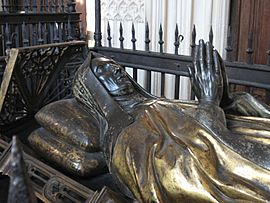
Margaret died at Westminster Abbey on 29 June 1509. This was the day after her grandson Henry VIII's 18th birthday. It was also just five days after his coronation and a little over two months after her son's death. She is buried in the Henry VII Chapel of the Abbey. Her tomb is near the graves of later kings and queens.
Her tomb was made by Pietro Torrigiano. The golden bronze statue on the tomb shows Margaret resting her head on pillows. Her hands are raised in prayer. She is wearing clothes that widows wore. The face was probably made from a death mask. The black marble tomb has bronze symbols, including a yale, which was her special animal symbol.
Erasmus, a famous scholar, wrote the Latin words on her tomb. In English, it says that Margaret was the mother of Henry VII and grandmother of Henry VIII. It also mentions that she gave money for monks, a school, a preacher, and two lecturers. She also founded two colleges at Cambridge.
Margaret's Lasting Impact
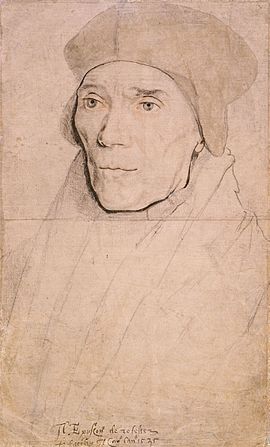
Lady Margaret Beaufort always supported art and learning.
While married to Lord Stanley, Margaret helped build chapels in Wales. She also supported the new technology of printing books. She ordered the first book from William Caxton in 1483. Six years later, she asked for an English translation of a French story. This marked the start of a time when the Tudors greatly supported arts and learning. Margaret also translated books herself. She was the first English translator of The Imitation of Christ whose name we know.
In 1497, she announced she wanted to build a free school for the public in Wimborne. After her death, Queen Elizabeth's School, Wimborne Minster was created.
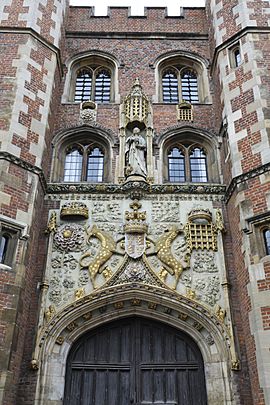
In 1502, she started a special teaching position for religious studies at Cambridge University. In 1505, she rebuilt and made bigger an old college at Cambridge called God's House. It became Christ's College, Cambridge. She is still honored as the founder of the college. You can even see her signature carved on one of the buildings. In 1511, St. John's College, Cambridge was founded using money from her estate. Both colleges use her special crest and motto. Many clubs and societies at these colleges are named after her.
In 1502, she also started a religious teaching position at the University of Oxford. Lady Margaret Hall, Oxford, the first college at Oxford for women (founded in 1878), was named in her honor.
Margaret was a practical woman. When some of her lands were threatened by flooding, she started a big project to drain the water. She hired foreign engineers to build a large sluice (a gate to control water flow) in Boston. She also paid for the repair of a church in Somerset.
A school in Riseley, Bedfordshire, near her birthplace, is named after her. In 1993, the Margaret Beaufort Institute of Theology in Cambridge was founded in her honor.
Portraits of Margaret Beaufort

There are no portraits of Margaret Beaufort that were painted while she was alive. All the pictures we have show her in her later years. She is usually wearing a tall, white headdress and praying. Most of these portraits were made after her death. They were meant to show loyalty to the Tudor kings. They might be based on a lost original painting or on the statue on her tomb.
One famous portrait shows her praying in her private room. Her prayer book is open before her. The walls are decorated, and her family's symbols are woven into the tapestries. These symbols include the Tudor rose and the portcullis (a gate symbol) of the Beaufort family.
Margaret in Books and on Screen
In Historical Fiction Books
- Betty King wrote The Lady Margaret (1965) and The King's Mother (1969).
- Iris Gower wrote Destiny's Child (1999).
- Philippa Gregory features Margaret Beaufort in her Plantagenet and Tudor Novels series, including The Red Queen (2010).
- Rebecca Gablé wrote Das Spiel der Könige (The Game of Kings) (2007), where Margaret is a character.
- Livi Michael wrote Succession (2014).
On Screen (TV Shows)
- Marigold Sharman played Lady Margaret in the BBC show Shadow of the Tower (1972).
- Sally Edwards played Lady Margaret in Princes in the Tower (2005).
- Amanda Hale played Lady Margaret in The White Queen (2013).
- Michelle Fairley played Margaret in The White Princess (2017).
- Harriet Walter played an older Margaret in The Spanish Princess (2019).
- Nina Marlin and Phoebe Sparrow played Margaret in Royal Bastards: Rise of the Tudors (2021).
In Music
- Renée Lamb played Margaret Beaufort in the cast recording of A Mother's War (2020), a musical about the Wars of the Roses.
See also
 In Spanish: Margarita Beaufort para niños
In Spanish: Margarita Beaufort para niños
- Christopher Urswick – a priest who helped Margaret Beaufort and Henry Tudor.
Images for kids
-
Monumental brass of Edmund Tudor, St David's Cathedral, Pembrokeshire
-
Pembroke Castle in 2007, the Norman castle where 13-year-old Margaret gave birth to Henry Tudor in 1457
-
Coat of arms at Christ's College, Cambridge with two yales as supporters
-
Presentation miniature of Dictes and Sayings of the Philosophers, one of the first books in the English language, printed by William Caxton. The miniature depicts Anthony Woodville presenting the book to Edward IV, accompanied by his wife Elizabeth Woodville, his son Edward, Prince of Wales and his brother Richard, Duke of Gloucester
-
The Great Gate of St. John's College, Cambridge
-
Stained glass panel in All Saints' Church at Landbeach, Cambridgeshire, thought to depict a younger Margaret.





